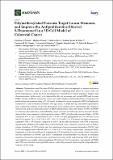Por favor, use este identificador para citar o enlazar a este item:
http://hdl.handle.net/10261/177053COMPARTIR / EXPORTAR:
 SHARE SHARE
 CORE
BASE CORE
BASE
|
|
| Visualizar otros formatos: MARC | Dublin Core | RDF | ORE | MODS | METS | DIDL | DATACITE | |

| Título: | Polymethoxylated flavones target cancer stemness and improve the antiproliferative effect of 5-fluorouracil in a 3D cell model of colorectal cancer |
Autor: | Pereira, Carolina V.; Duarte, Marlene; Silva, Patrícia; Bento da Silva, Andreia; Duarte, Catarina M. M.; Cifuentes, Alejandro CSIC ORCID ; García-Cañas, Virginia CSIC ORCID ; Bronze, Maria do Rosário; Albuquerque, Cristina; Serra, Ana Teresa | Palabras clave: | Orange peel extract Polymethoxylated flavones Tangeretin Scutellarein tetramethylether Synergistic interactions 5-fluorouracil Colorectal cancer Cancer stem cells 3D cell models |
Fecha de publicación: | 2-feb-2019 | Editor: | Multidisciplinary Digital Publishing Institute | Citación: | Nutrients 11(2): 326 (2019) | Resumen: | Polymethoxylated flavones (PMFs) from citrus fruits are reported to present anticancer potential. However, there is a lack of information regarding their effect on cancer stem cell (CSC) populations, which has been recognized as responsible for tumor initiation, relapse, and chemoresistance. In this study, we evaluated the effect of an orange peel extract (OPE) and its main PMFs, namely, nobiletin, sinensetin, tangeretin, and scutellarein tetramethylether in targeting cell proliferation and stemness using a 3D cell model of colorectal cancer composed of HT29 cell spheroids cultured for 7 days in stirred conditions. Soft agar assay, ALDH1 activity, and relative quantitative gene expression analysis of specific biomarkers were carried out to characterize the stemness, self-renewal, and mesenchymal features of HT29 cell spheroids. Then, the impact of OPE and PMFs in reducing cell proliferation and modulating cancer stemness and self-renewal was assessed. Results showed that, when compared with monolayer cultures, HT29 cell spheroids presented higher ALDH1 activity (81.97% ± 5.27% compared to 63.55% ± 17.49% for 2D), upregulation of CD44, PROM1, SOX9, and SNAI1 genes (1.83 ± 0.34, 2.54 ± 0.51, 2.03 ± 0.15, and 6.12 ± 1.59 times) and high self-renewal capability (352 ± 55 colonies compared to 253 ± 42 for 2D). Incubation with OPE (1 mg/mL) significantly inhibited cell proliferation and modulated cancer stemness and self-renewal ability: colony formation, ALDH1 activity, and the expression of cancer stemness biomarkers PROM1 and LGR5 were significantly reduced (0.66 ± 0.15 and 0.51 ± 0.14 times, respectively). Among all PMFs, tangeretin was the most efficient in targeting the CSC population by decreasing colony formation and the expression of PROM1 and LGR5. Scutellarein tetramethylether was shown to modulate markers of mesenchymal/metastatic transition (increasing CDH1 and reducing ZEB1 and SNAI1) and nobiletin was capable of downregulating PROM1 and SNAI1 expression. Importantly, all PMFs and OPE were shown to synergistically interact with 5-fluorouracil, improving the antiproliferative response of this drug. | Versión del editor: | http://dx.doi.org/10.3390/nu11020326 | URI: | http://hdl.handle.net/10261/177053 | DOI: | 10.3390/nu11020326 | ISSN: | 2072-6643 |
| Aparece en las colecciones: | (CIAL) Artículos |
Ficheros en este ítem:
| Fichero | Descripción | Tamaño | Formato | |
|---|---|---|---|---|
| nutrients-11-00326-v3.pdf | 2,71 MB | Adobe PDF |  Visualizar/Abrir |
CORE Recommender
PubMed Central
Citations
12
checked on 06-abr-2024
SCOPUSTM
Citations
31
checked on 17-abr-2024
WEB OF SCIENCETM
Citations
28
checked on 29-feb-2024
Page view(s)
243
checked on 19-abr-2024
Download(s)
209
checked on 19-abr-2024

